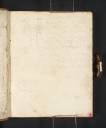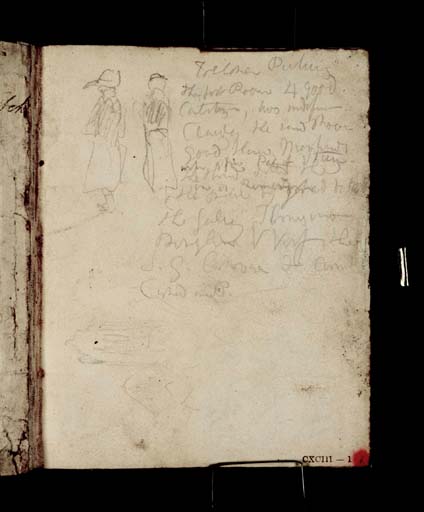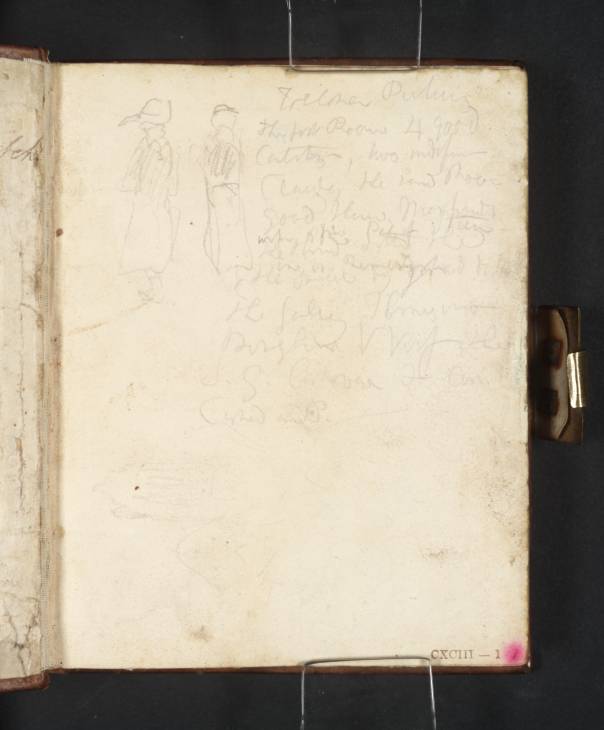Joseph Mallord William Turner Sketches of Two Women and a Building; and Notes by Turner on the Palazzo Torlonia-Bolognetti, Rome 1819
Image 1 of 2
-
 Joseph Mallord William Turner, Sketches of Two Women and a Building; and Notes by Turner on the Palazzo Torlonia-Bolognetti, Rome 1819
Joseph Mallord William Turner, Sketches of Two Women and a Building; and Notes by Turner on the Palazzo Torlonia-Bolognetti, Rome 1819 -
 Joseph Mallord William Turner, Sketches of Two Women and a Building; and Notes by Turner on the Palazzo Torlonia-Bolognetti, Rome 1819 (Enhanced image)Enhanced image
Joseph Mallord William Turner, Sketches of Two Women and a Building; and Notes by Turner on the Palazzo Torlonia-Bolognetti, Rome 1819 (Enhanced image)Enhanced image
Joseph Mallord William Turner,
Sketches of Two Women and a Building; and Notes by Turner on the Palazzo Torlonia-Bolognetti, Rome
1819
Joseph Mallord William Turner 1775–1851
Folio 1 Recto:
Sketches of Two Women and a Building; and Notes by Turner on the Palazzo Torlonia-Bolognetti, Rome 1819
D16762
Turner Bequest CXCIII 1
Turner Bequest CXCIII 1
Pencil on white wove paper, 115 x 94 mm
Inscribed by the artist in pencil (see main catalogue entry)
Inscribed by John Ruskin in red ink ‘1’ bottom right
Stamped in black ‘CXCIII 1’ bottom right
Inscribed by John Ruskin in red ink ‘1’ bottom right
Stamped in black ‘CXCIII 1’ bottom right
Accepted by the nation as part of the Turner Bequest 1856
References
1909
A.J. Finberg, A Complete Inventory of the Drawings of the Turner Bequest, London 1909, vol.I, p.574, as ‘Two slight figures and a building; also – “Torlonia Pictures | the first Room 4 good | Cat ... two indefinite | Claude, the ... Room | good, &c. | the Gallery Thomasino | Borghese V. Verf. the | S. G. Canova, &c.” ’.
1984
Cecilia Powell, ‘Turner on Classic Ground: His Visits to Central and Southern Italy and Related Paintings and Drawings’, unpublished Ph.D thesis, Courtauld Institute of Art, University of London 1984, pp.147, 151, 483 notes 84 and 85, 484 note 1.
1987
Cecilia Powell, Turner in the South: Rome, Naples, Florence, New Haven and London 1987, pp.61, 65, 203 notes 1, 49 and 50.
This page contains very slight, rough sketches of two female figures, both of whom are carrying pots or baskets on their heads. Also in the bottom left-hand corner, parallel with the left-hand edge, is another faint drawing which appears to depict part of a building. The majority of the sheet, however, is devoted to handwritten pencil notes, much of which is illegible. The inscription, partially transcribed by Finberg,1 reads:
Torlonia Pictures | the first Room 4 good | Cat[...], two indefinite | Claudes, the 2nd Room | good fluid M[...] | with P[...] Pic of [?Steen] | the third artist the | one is Rembrandt | the p[?encil] by G[...] di [...] | the Gallery [?Thorwaldsen] | Borghese V. Verf. the | S.G. Canova F Cam | Cupid and P
Cecilia Powell has suggested that the last part of the inscription indicates that Turner visited the studio of the Danish sculptor, Bertel Thorwaldsen (1770–1844), and that, additionally, he was taken by Antonio Canova (1757–1822) to see the latter’s famous sculpture of Pauline Borghese as Venus Victrix 1805–8 in the Palazzo Borghese.2 However, a more likely explanation is that these comments refer to the Palazzo Torlonia-Bolognetti, an opulent palace which, before its demolition at the beginning of the twentieth century, stood in Piazza Venezia, Rome. Also known during the nineteenth century as the Palazzo Nuova di Torlonia, the palace had been acquired by the Torlonia family in 1807 and lavishly redecorated by many of the most celebrated artists of the period including Thorwaldsen and Canova, and a fresco by Vincenzo Camuccini (1771–1844), depicting the Marriage of Cupid and Psyche.3
Nicola Moorby
March 2011
How to cite
Nicola Moorby, ‘Sketches of Two Women and a Building; and Notes by Turner on the Palazzo Torlonia-Bolognetti, Rome 1819 by Joseph Mallord William Turner’, catalogue entry, March 2011, in David Blayney Brown (ed.), J.M.W. Turner: Sketchbooks, Drawings and Watercolours, Tate Research Publication, December 2012, https://www

